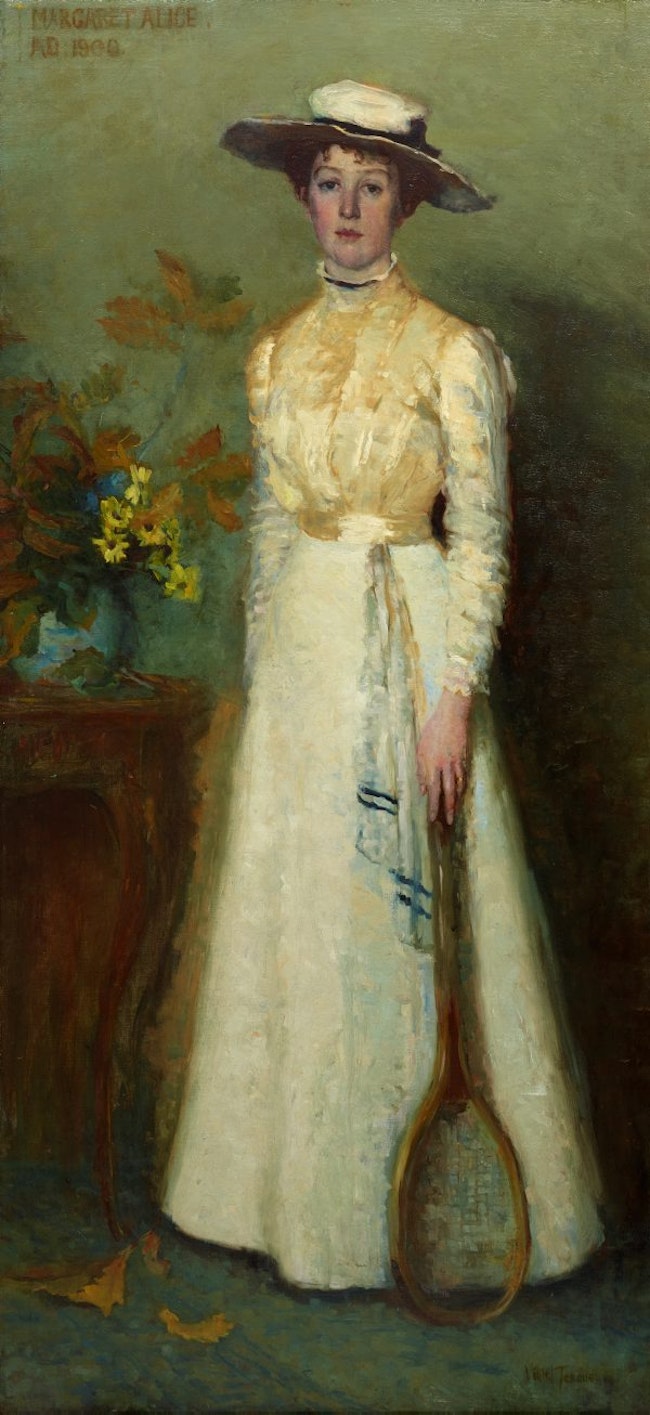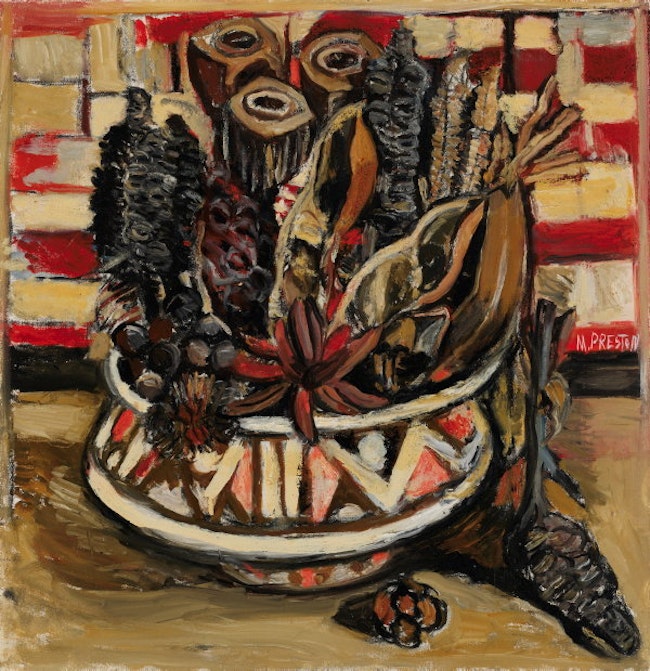The work of women
It’s exciting when a painting comes along that disrupts well-known narratives of Australian art. An intriguing recent purchase made through the Australian Masterpiece Fund is one such work.

Mary Cockburn Mercer (Landscape) 1925, Art Gallery of New South Wales, © Estate of Mary Cockburn Mercer
The untitled cubist landscape by Mary Cockburn Mercer (1882–1963) was painted when the artist lived in France in the 1920s. An accomplished modernist composition, the painting is also notable for its date of 1925. This was a few years before the burgeoning modernists Grace Crowley, Anne Dangar and Dorrit Black enrolled in French cubist André Lhote’s summer school at Mirmande in south-east France and created what are commonly considered to be some of the first cubist landscapes by Australian artists.
Mercer’s work, which reveals her to be a confidently modern artist by 1925, tells of another Australian trailblazer, but one whose name is largely unfamiliar today. This acquisition is even more tantalising because the whereabouts of most of Mercer’s early work remains unknown. What we mainly know of Mercer’s practice are paintings from later in her career, after she returned to Australia in 1938. How did this ‘forgotten’ Australian artist come to be painting radical landscapes in France in the 1920s?
Mercer led a remarkable and peripatetic life. Born in Scotland while her Australian mother was visiting her ancestral homeland, Mercer grew up in Victoria and Europe. At age 17 she yearned for the bohemian life of Paris and fled to Montparnasse. There she mingled with avant-garde writers, poets and artists, as well as painters including Picasso, Marc Chagall, Marie Laurencin, Jules Pascin and Kees van Dongen. She also had a relationship with Australian Janet Cumbrae Stewart, an exceptional figure artist working in a very different aesthetic tradition from the progressives of Paris.
Mercer studied cubist composition with Lhote in France during the 1920s and is also thought to have worked as his assistant and translator. This would have made her a crucial figure in his school, which attracted many non-French-speaking artists from across the globe in their quest to study modern art.
By 1922 Mercer had moved to the port village of Cassis in the south of France, where she built a house on the clifftops. It was here that she is thought to have painted this landscape, and it may be her own home that we can see in the left-hand corner of the composition. The influence of Lhote’s teaching is evident where the cubist geometry of fractured planes is ultimately integrated into a rhythmically driven whole. As we know little of Mercer’s other work from this period, it is difficult to single out her distinct stylistic traits. However, the painting does stand out for its dynamic repetition of forms, the way that Mercer instils a great sense of movement that ignites the composition, and her brooding palette of purple and green landscape hues.
During the 1920s and 1930s Mercer lived in France, on the island of Capri, the Canary Islands, and in Spain, where she travelled with her German lover during the civil war (possibly the link to the German provenance of this work). Leaving him, Mercer escaped Spain and travelled to Tahiti, where she lived for a while, as well as an island off Guam where she met another great artist-wanderer, Scottish-born Ian Fairweather. The two would reconnect back in Melbourne.
Mercer moved back to Melbourne in 1938 and settled there for a time. Her work from this period shows that she shed the more overt cubist references that are apparent in the 1925 painting and moved towards an inflated modern figurative style. She regularly exhibited with the newly formed Contemporary Art Society of Victoria, although her nude paintings were deemed decadent and hung behind doors to hide them from full view. Mercer returned to France late in life and died there in 1963.
Although she was a dazzling presence in Melbourne’s mid-century art scene, she has since been largely forgotten and works by her are difficult to source. For now, she remains an elusive, intriguing artist. It is so often the case that we approach women’s art histories through their biographies, and indeed we know more about Mercer’s life than we do of her work. But ultimately it is an artist’s work, not their life, that we need to focus on. This acquisition is significant for what it might tell us of the artist’s practice as well as her contribution to modern art histories. The re-emergence of this fascinating work invites further investigation.

Violet Teague Margaret Alice 1900, Art Gallery of New South Wales
Violet Teague Margaret Alice 1900, Art Gallery of New South Wales
The purchase of the work was made possible by the Art Gallery’s Australian Masterpiece Fund.
Originally, the fund was created to assist with the acquisition of important works of Australian art, including paintings by John Brack, Charles Conder, E Phillips Fox and Tony Tuckson.
In 2014, we acquired The window 1956 by Grace Cossington Smith, the brilliant colourist who was a pioneer of modernism in Australia.
In 2017, we were able to purchase Violet Teague’s magnificent Margaret Alice 1900, which has been on display in our Grand Court galleries since that time. This late Victorian portrait is near unique in its scale and ambition, but also because it shows a young sporting woman who has just played or is about to play a match of tennis. This painting was offered privately to the Gallery and, thanks to the Australian Masterpiece Fund, we were able to quickly secure it.
Since 2021, under the title Australian Masterpiece Fund 3, the fund has a new focus: to provide essential financial reserves to acquire significant 19th- and 20th-century works by women artists for our collection.
The Art Gallery holds the premier collection of Australian art, built over the last 150 years through purchase and donation. Like all historically formed collections, there is a bias towards male artists and the Art Gallery’s curators have been engaged in significant work in recent years to address this imbalance. Despite acquiring some transformative works, we still have a considerable way to go and, in recent years as the market has risen for works by women artists, it has become harder for us to compete for acquisitions.

Margaret Preston Still life (seed pods) c1949, Art Gallery of New South Wales © Margaret Rose Preston Estate/Copyright Agency
Margaret Preston Still life (seed pods) c1949, Art Gallery of New South Wales © Margaret Rose Preston Estate/Copyright Agency
In 2022, the Australian Masterpiece Fund was used to purchase Still life (seed pods) c1949 by Margaret Preston, an exceptional late work by this hugely significant and much-loved artist. In her still life compositions, Preston sought statements of her modern age and expressions of the distinctions of nation. Expressing these ideals, this painting is a tough and ‘messy’ still life, an assembly of cobs, woody flowers and seeds of native plants that are the antithesis of the pleasingly-coloured posy that the genre of flower painting traditionally stood for.
The Art Gallery receives no government funding for the acquisition of artworks. The Australian Masterpiece Fund enables us to keep our leading collection position in Australia and to continue to diversify our holdings to represent the essential contribution women artists have made to Australian art.
You can donate to the Australian Masterpiece Fund through our annual appeal.